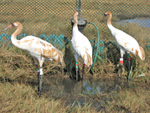|
Journey
North News: Winter
& Spring 2010
Posted
Fridays:
Feb. 12, 26, Mar. 12, 26, Apr. 2, 9, 16,
22, 30, May 14
 |
FINAL
Whooping Crane Migration Update: May 14, 2010
The
journey north is done and the miraculous cycle of
life continues. Today we celebrate the exciting
events or recent days with photos, slideshows, audio
and and video. Five new nests in Wisconsin have everyone
excited,
and habitat conditions in Canada are good. Chicks
are coming! View nests from the air with Eva and
smile at the first
babies
in the Class of 2010. Why is this one (photo)
napping by a puppet? Create your own captions for
what they'll do this summer.
Photo Barb Clauss, Patuxent
Wildlife Research Center |
 |
Whooping
Crane Migration Update: April 30, 2010
Many
of the 262 western cranes are still migrating, while
at least 89 of the new eastern flock are confirmed
home. No new nests, but the first hatchling for the
new Class of 2010 is expected May 2 at the captive
breeding center in Maryland. The journal question
takes stock of the flock. Visit International Migratory
bird Day with a podcast by craniac Mark Chenoweth.
What could be the trouble with the crane in this
photo?
Our
slideshow
has the
answer. Photo Laura C.
Williams
|
 |
Whooping
Crane Migration Update: April 23, 2010
The "St.
Marks Two" who left FL April 14 completed their migration
April 21! Wearing mini GPS devices, so did the western flock's
RAY and YAY; what did researchers learn? Scientist Brian
Johns
helps
us
explore
how many eggs it takes to make another Whooping crane egg,
and
an audio clip by Operation Migration's Joe Duff
shares his thoughts on how cranes know when they're home.
Hear an Earth Day Podcast too. What do you see in this
photo—and
what don't you see? Find out!
Photo
Sue Kersey |
 |
Whooping
Crane Migration Update: April 16, 2010
The
last two dawdlers, #906 and #912, finally left Florida’s
St. Marks NWR on April 14. Four Texas whoopers have
crossed into Canada and we introduce Lea from our Canada
Field Team. How many days did the Class of 2009 chicks
spend on the wintering grounds? Nesting news from Wisconsin
and a new slideshow give lots to think about, and our
photo offers this challenge: What might explain
why these cranes flew away? Photo
Sue Kersey |
 |
Whooping
Crane Migration Update: April 9, 2010
The "Chass
9" crane-kids began migration April 5, with two left
at St. Marks. Some Texas whoopers have reached South Dakota!
Eight nests with adult pairs incubating have already been
found in Wisconsin; calculate hatch dates to circle on your
calendar. Dig into our interview with the researcher who
banded RAY and YAY and ponder this photo to discover what
makes crane eyelids unlike yours.
Photo Eva Szyszkoski |
 |
Whooping
Crane Migration Update: April 2, 2010
The "St.
Marks 8" crane-kids completed migration April 1! Fly their
journey with a quick video clip. Five 2009 DAR chicks are back
too. Meanwhile, a record whooper sighting created excitement
in Kansas and the time of peak Texas departures
is near. Our slideshow tells how two wild cranes nicknamed
YAY
and RAY
helped launch a new research project. One of those cranes
is in this photo. What's happening? Answers and more in this
week's report!
Photo: Jessica Rempel
|
 |
Whooping
Crane Migration Update: March 26, 2010
Whooping
cranes are homeward bound in both the Central and Eastern
flyways. They include eight 2009 crane-kids! Discover which
have reached
Wisconsin, including the first 2009 DAR chick. How far north
have early migrants of the Western flock reached? Consider
why small groups leave at different times. See some human
actions
that help cranes in our slideshow — and this "mystery"
photo.
Photo: AltaLink
|
 |
Whooping
Crane Migration Update: March 12, 2010
Migration
is underway! One crane from the Texas wintering ground has
made the earliest departure on record,
while one '09 chick has her own claim to migration fame. At
least 27 older cranes in the Eastern flock are on the journey
north. Meet a "Crane Extraordinaire" in our slideshow
and test your skill at identifying whoopers in our photo quiz.
How could it be useful for a crane to change its crown color?
Photo
Eva Szyszkoski, ICF |
 |
Whooping
Crane Migration Update: February 26, 2010
“Things
are looking up for this very endangered species,” reports
Tom Stehn from the main flock’s Texas wintering
grounds where the count is 263 Whooping cranes and
plenty of rain.
Three Eastern cranes may have begun migration with
sandhill cranes. The crane-kids, content in Florida,
learned to eat blue crabs.
Meet the flock’s most productive pair in our
slideshow and compare the two flocks we're tracking.
Discover why 929 has a different
VHF transmitter (see photo) from
all
the others. Photo
Sara Zimorski, ICF
|
 |
Whooping
Crane Migration
Update: February 12, 2010
Get ready! Newly banded and set free, the
Class of 2009 crane-kids have begun their final reintroduction
steps into
the wild at two Florida wildlife refuges. Learn to identify
them by deciphering their banding codes. Investigate the outlook
for the flock in Texas with the photo story of wild crane Scarbaby.
Tour the wintering grounds of both flocks through slideshows.
Answer: What will the two cranes pictured here do next in their
standoff? Photo Eva Szyszkoski, ICF |
 |
Welcome
and Orientation
What endangered species stands nearly five feet tall with
wingspans wider than most cars? Whooping Cranes! Our reports
begin on February 13, when these magnificent birds are on
their wintering grounds. Regular
WHOOPING CRANE SPRING MIGRATION UPDATES will be posted here
on Fridays. (See schedule above.) Download your official
journals, make your map of Whooping Crane habitats, and
get ready for the journey north adventure! Photo
Operation Migration
|
|













